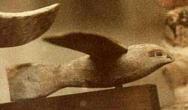Ancient Chinese books recorded that between 770-475 BC, in the Spring and Autumn period, Lu Ban created some flying machines. This led Lu Ban to be acknowledged as the father of all craftsmanship. In Mozi·Luwen, it reads “Lu Ban cut up some bamboo and wood and made a wooden bird. It stayed in the sky for three days." Lu Ban also made a big wooden kite in order to spy on enemies during war. In Hongshu it reads, “Lu Ban made a wooden kite to spy on cities in the State of Song." Besides, Lu Ban also made a passenger plane. According to Youyang Zazu [A Collection of Essays from Youyang] of the Tang Dynasty, Lu once worked in a place very far away from his hometown. He missed his wife very much, so he made a wooden bird. After being redesigned several times, the wooden kite could fly. Lu Ban went home on the kite to meet his wife and returned to work the next day.
There was also an interesting example in the West regarding a wooden bird. In 1898, French Archeologist Lauret dug out a wooden bird from an ancient Egyptian tomb in Saqqara. It was dated at around 200 BC.
| ||
(Photo: courtesy of Dawoud Khalil Messiha)
Because people had no concept of flying at that time, it was labelled “wooden bird" and had gathered dust for more than 70 years in a museum in Cairo. In 1969, Khalil Messiha, an Egyptian doctor who likes making models, happened to see it. This "wooden bird" reminded Messiha of his earlier experience of making model planes. He thought it was not just a bird, since it had no claws, no feathers and no horizontal tail feathers. Surprisingly, its tail was vertical, and it had an airfoil cross-section, which qualified it to be a model airplane. He then made a replica of the model. Although he didn't know how ancient Egyptians flew it, when he threw the model, he found it could glide. Further testing showed it was not only able to glide, but was also on a scale similar to modern gliders.
Later, scientists found this model was very similar to modern propelled gliders, which can fly in the air on their own. With a small engine, they can fly at a speed of 45-65 miles per hour (or 72-105 kilometers per hour), and can even carry considerable cargo. Since ancient Egyptian artisans used to build models before constructing real objects, it is possible that this kind of wooden bird was used for transportation, just like the wooden kite that Lu Ban made.
Modern studies on flight started about 200 years ago. In 1903, after the Wright Brothers successfully completed the first manned flight, aviation theories began to be formulated. However, Lu Ban and ancient Egyptians seemed to be aware of how to use such theories a very long time ago. This circumstance gives cause to reconsider the history of cultural development that modern humankind now believes. It is possible that ancient people knew more than what we believe.
* * *
You are welcome to print and circulate all articles published on Clearharmony and their content, but please quote the source.











 more ...
more ...